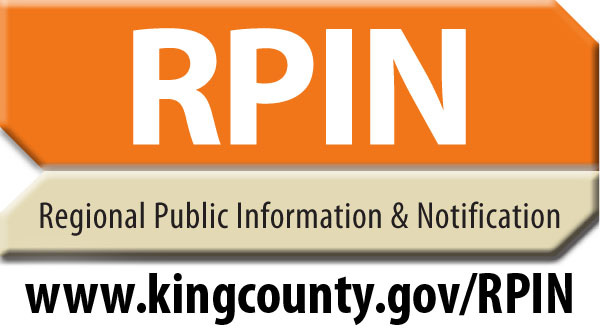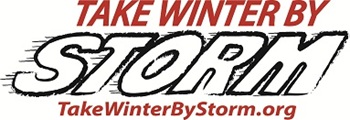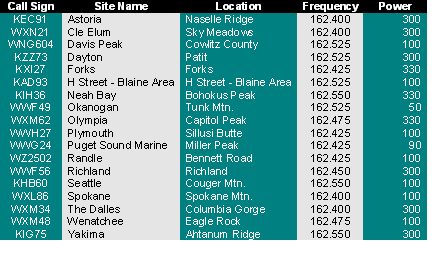
| EMERGENCY MANAGEMENT AND DISASTER PREPAREDNESS | ||||||
Emergency Management is the continuous process by which all individuals, groups and communities manage hazards in an effort to avoid their devastation. In the City of Black Diamond, Emergency Management is built upon the following four phases: Mitigation, Preparedness, Response and Recovery.
It's also a good idea to get to know your neighbors. During winter emergencies you can help each other and share needed resources. Find more tips and checklists at www.takewinterbystorm.org. Winter shelter information is provided by |
||||||
 |
 |
 |
||||
PREPAREDNESS INFORMATION |
NOAA Radio | |||||
| Mitigation In the Mitigation Phase, the steps to eliminate or reduce disaster damages effecting the City and it's citizens are taken. Strategies to be considered are removing or eliminating the hazard, reducing or limiting its amount or size, segregating the hazard from that which needs to be protected, reducing the likelihood of the hazard occurring, controlling its rate of release, establishing hazard warning and communication procedures, and establishing structural and non-structural protective measures. Examples of mitigation include activities such as retrofitting buildings for earthquakes, elevating levies around flood prone homes and businesses, locating development outside of flood zones, and creating wildfire buffers around developments in vulnerable areas. |
NOAA weather radio broadcasts are made on one of seven high-band FM frequencies ranging from 162.40 to 162.55 MHz. These frequencies are usually not found on the average radio, but require a specially built receiver to pick up the broadcasts. NOAA weather radio broadcasts can usually be heard as far away as 40 miles from the antenna site, often further. The effective range depends on many factors, including height of the antenna, terrain, quality of the receiver, and atmospheric conditions. NOAA Weather Radio listings in Washington and Surrounding Areas are located above. |
NOAA Weather Radio is a service of the National Oceanic and Atmospheric Administration (NOAA) of the Department of Commerce. NOAA Weather Radio provides continuous broadcasts of the latest weather information directly from the National Weather Service offices across the country. Weather messages are taped and run in a cycle lasting on an average of four to six minutes, and are updated frequently throughout the day. The NOAA Weather Radio network broadcasts from over 400 FM transmitters across the country on seven frequencies in the VHF band, ranging from 162.40 to 162.55 MHz above the commercial FM band. Eighteen NOAA Weather Radio stations broadcast in Washington. During severe weather, the National Weather Service can interrupt the routine weather broadcasts and air special flood, weather watch, warning, or advisory messages. Specially designated warning receivers can be activated. Such receivers either sound an alarm indicating that an emergency exists, alerting the listener to turn the receiver up to audible volume, or, when operated in mutated mode, are automatically turned on so that the warning message is heard. "Warning Alarm" receivers are especially valuable for homes, businesses, schools, hospitals, public-safety agencies, and news media offices. Under a January 1995 White House policy statement, NOAA Weather Radio was designated the SOLE government operated radio station to provide direct warning information into private homes and businesses for both natural disasters and nuclear attack. This includes hazardous conditions that pose a threat to life and safety, both at a local and national level.
|
||||
Preparedness This is also the phase that individuals and groups within our community should prepare to lessen the impacts of a disaster. It is important to observe the distinction between a disaster and emergency. An “emergency” is an event that requires response from service providers (i.e. police and fire) and that while potentially devastating to some members of the community, the event is manageable by emergency service providers. However, a “disaster” is when an event is so traumatic that it disables the emergency response system from being able to respond to the event (e.g. Hurricane Katrina). This is why it is so important that individuals in the community take steps to be prepared for 3-7 days without help in the event of disaster. |
||||||
| Response In the Response Phase, actions are taken immediately before, during or directly after an emergency occurs, to save lives, minimize damage, and to enhance the recovery activities. Activities include notification and activation of personnel and services, continuity of government, establishing data and voice communications, dissemination of public information, evacuation or sheltering in place, insuring personnel identification and accountability, mass care, providing for mental and physical well-being of affected individuals. |
||||||
| Recovery The goal of the Recovery Phase is to return the community's systems and activities to normal. Tasks in this phase include restoring organization and staffing, restoring utilities, debris removal, restoration and salvage, maintaining essential records, assessing damages, public and employee information, and identifying recovery funding. Long-term recovery includes restoring economic activity and rebuilding community facilities and housing. This also includes rebuilding in such a way as to mitigate damages should the same disaster strike again (e.g. earthquake, flood). |
||||||
HANDOUTS AND RESOURCES |
||||||
September is National Preparedness Month and the 13th anniversary of 9/11 - No one should live in fear of what “could” happen, but we shouldn’t live in denial or become complacent either. While the weather is still pleasant and kids are returning to school, take time to prepare for emergencies in your home, school, organizations, businesses, and communities. Click here to see the three easy steps you can follow for making preparedness a part of your everyday life. - Posted 09-10-14 (NEW) Looking for a shelter during the cold weather? Dial 2-1-1 from your phone for the nearest location to you or click on the this link to view a printable PDF. - Posted 12-04-13 TEXT FIRST. TALK SECOND. - The September 11, 2001 terror attacks, Hurricane Katrina and the 2011 East Coast earthquake all share something in common – each caused massive mobile phone service disruption for millions of Americans. Mobile call volume simply overwhelmed provider capacity during these incidents. The desire to call loved ones after an emergency or disaster is natural. However, preparedness experts universally agree that during an emergency and its immediate aftermath, communicating via SMS text messaging should be your first choice. 40%of cell owners said they found themselves in an emergency situation in which having their phone with them helped This is because non-essential calls often shutdown wireless phone service and prevent 911 calls from getting through and emergency personnel being unable to communicate with each other. In fact, just a single one-minute phone call takes up the same bandwidth as 800 short SMS text messages. Also, unlike phone calls, text messages get through even when the network is congested. Even if it gets a "busy signal" on its first try the text system will continue to keep trying to deliver your message. This makes text messaging perfect for sending non-emergency messages like “R U OK” and “I M OK.” For more information, visit Safe America Foundation. - -Posted 10-10-13
Whooping Cough (Pertussis) General Information Swine Flu (H1N1) Information
|
||||||
| EMERGENCY CONTACT INFORMATION | ||||||
What to do to make it through |
Black Diamond Police |
Washington State Child Protective Services Federal Emergency Management Agency |
||||
2011 - City of Black Diamond. City, Police, Court and Fire information. Contact Us - Disclaimer.
